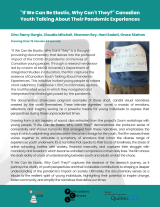
Canadian Youth Talking About their Pandemic Experiences
A report by UNICEF in the early days of the pandemic predicted that young people would experience the greatest impact. What followed were numerous studies looking at the impact of the pandemic on young people in relation to their mental health and well-being, their physical health, and their education. But they were mostly studies about young people and not with young people.
What might it mean to listen to young people themselves and their experiences of the pandemic?
A research study “Young People, Well-being, and Connectedness in the Time of Distancing”, conducted between November 2021 and April 2023, invited young people between the ages of 16 and 24 from across Canada to engage in participatory research invited young people between the ages of 16 and 24 from across Canada to engage in participatory research. Along with producing these cellphilms, they also had the opportunity to screen their cellphilms in small groups and to reflect on the messages. Young people chose many different genres to represent their ideas and messages in their cellphilms.Most adopted a ‘no faces’ style. The cellphilms included in this video highlight key themes of young people’s experiences of the pandemic.
Un rapport d'UNICEF au tout début de la pandémie a prédit que les jeunes seraient les plus affecté.es par la pandémie. Plusieurs études par la suite ont évalué les conséquences de la pandémie sur les jeunes, sur leur santé mentale, leur bien-être, leur santé physique et leur instruction. La plupart portaient sur les jeunes, sans être faites avec les jeunes.
Et si on écoutait les jeunes et leur expérience de la pandémie?
La recherche participative «les jeunes, leur bien-être et le sentiment de connexion en période de distanciation», entre novembre 2021 et avril 2023, a invité des jeunes du canada de 16 à 24 ans à créer de courts «cellphilms» (filmés avec leur téléphone) sur leur vécu en temps de pandémie, et leurs messages à transmettre à la classe dirigeante, au personnel enseignant et aux parents. Les jeunes ont aussi pu visionner les cellphilms en petits groupes et réfléchir ensemble sur les messages transmis. Les jeunes ont eu recours à différents genres pour représenter leurs idées et leurs messages. La plupart ont opté pour le style «sans visage». Les cellphilms qui suivent mettent en lumière des sujets centraux soulevés par les jeunes sur leur expérience de la pandémie.



